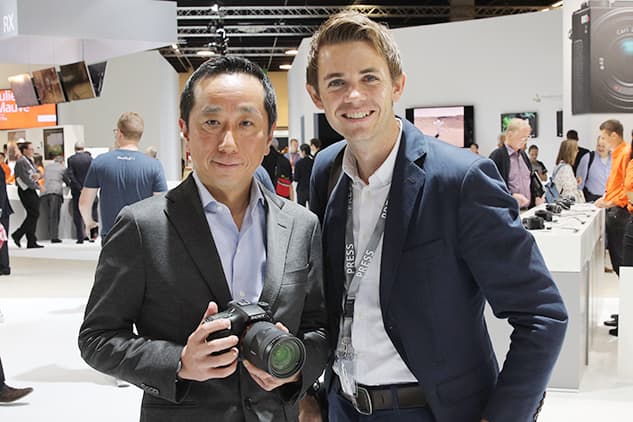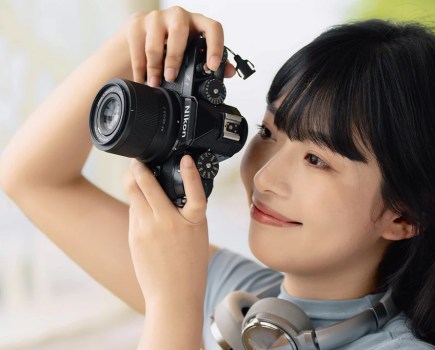During our recent visit to Photokina 2016, we had the opportunity to speak to Kimio Maki, Senior General Manager of the Digital Imaging Business Group, Sony Corporation. With the recently announced Sony A99 II in question, we asked for more information about this latest flagship model in the Alpha series and what the long-term future looks like for the Sony A-mount.
As well as answering our questions about the Sony A99 II, Kimio Maki talked to us about the competition in the mirrorless market and gave us an update on when the Sony production facility is expected to be back to full operation following the devastating Kumamoto earthquakes earlier in the year.
AP: Can you please tell us who Sony is out the target with the new A99 II that was announced yesterday at Photokina 2016?
KM: Our target base with the A99 II are those who’ve previously used A-mount cameras. There are a lot of existing A-mount customers around the world and it’s important we satisfy them.
AP: Can you tell us please how long the A99 II been in development?
KM: The camera has been in development for two years.
AP: What would you say to photographers who thought the Sony A-mount was dead?
KM: We’ve never said such a thing and we’re keeping the A-mount system as our asset. Running A-mount alongside the E-mount is very important. A-mount is a keeper.
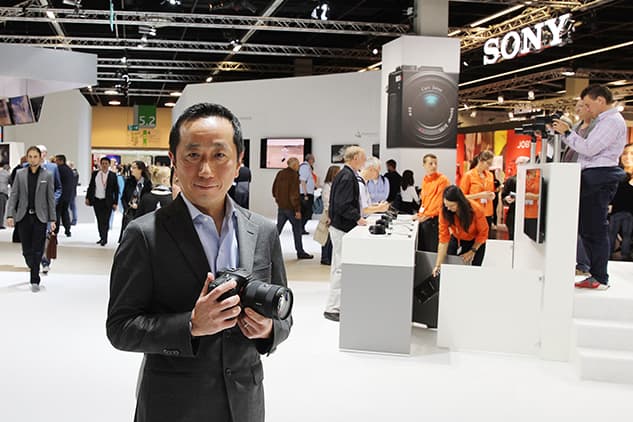
Kimio Maki, Senior General Manager of the Digital Imaging Business Group, Sony Corporation holds the A99 II on the Sony stand at Photokina 2016
AP: Why has Sony decided to continue with A-mount when you can use an adapter with the e-mount?
KM: It all comes down to the number of users who are using A-mount cameras such as the A99 and A77 II. If the customer exists we’re going to ensure the A-mount carries on. We’re not going to switch entirely from A-mount to E-mount. Quite simply, A-mount is A-mount and E-mount is E-mount. The two mounts have different character.
AP: Why would you choose an A99 II ahead of a smaller, lighter and more convenient system like the A7-series?
KM: If a customer wants to buy into the A-mount then all I can say is please buy it. I don’t recommend one mount ahead of the other, it’s entirely up to the customer. I’m not a customer so I’m not in the position to decide.
AP: Can you confirm that the 42-million-pixel sensor is the same as the one that’s used in the Sony A7R II?
KM: Basically it is the same, but certain areas of the electronic technology are slightly different.
AP: Have improvements been made to image quality compared to the Sony A7R II?
KM: Yes they have.
AP: Now there’s a new camera in A-mount, can we expect Sony to add additional lenses to the A-mount lineup?
KM: We have already got a huge lineup of A-mount lenses. If the customer recommends or requests something new then it’s important we listen to the customers voice. It depends entirely on the customers requirements.
AP: How does the autofocus system on the A99 II compare to the A7R II?
KM: The A99 II is a different system to the A7R II with different technology. Speed and accuracy is truly excellent on the new A99 II.
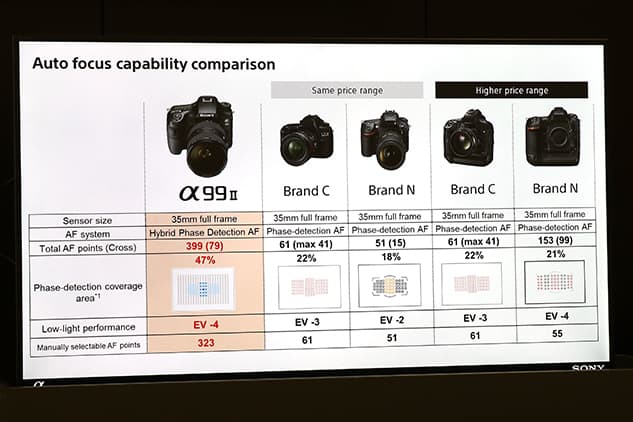
A slide presented to us during a workshop showing the A99 II’s autofocus capability and how it compares to its rivals
AP: Is the A99 II is better suited to sports and action photography than the A7R II?
KM: Yes it is.
AP: Why is the A99 II’s shutter lifespan (300,000 exposures) longer than other cameras?
KM: I can’t go into detail, but we’ve improved the shutter unit and it is now good for as many as 300,000 actuations.
AP: Will the A99 perform better than the A7R II would with A-mount lenses?
KM: Yes, the answer is that A-mount lenses attached to an A-mount camera is better.
AP: The A99 II doesn’t feature touchscreen control? What’s the reasoning for this?
KM: It’s usually a request from our general customers, however it’s not a request that we get from professionals. We may have to add touchscreen panels to our entry-level models, but professionals don’t require it. If the professionals change their mind and put in the request we may need to change this in the future.
AP: Does the A99 II feature a silent shutter mode like those found on the A7-series?
KM: No, there’s no silent mode on the A99 II.
AP: Many Sony A900 users didn’t feel the A99 was enough of an upgrade. Do you hope that many more A900 users upgrade to the A99 II?
KM: I hope that they will upgrade to this new model. Of course it’s the customers choice. We hope they do. A lot of it depends on how much they have already invested in the A-mount. There are many factors to consider when upgrading.
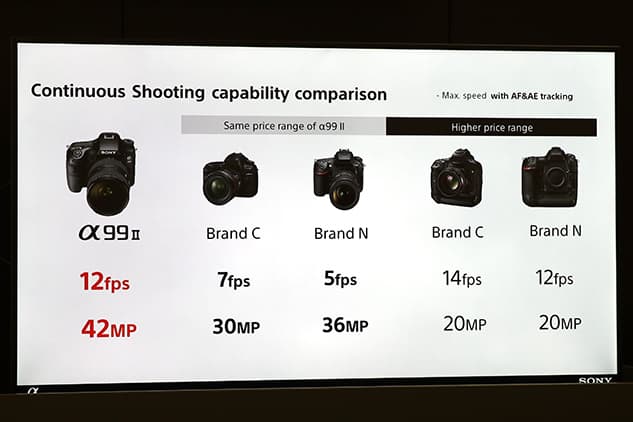
A slide presented to us during the Sony A99 II workshop showing the camera’s continuous shooting capability and how it compares to cameras of similar price and higher price
AP: What would you say to photographers who love the spec of the A99 II but think it could be too heavy for their daily camera?
KM: I have to admit it is heavier than the Alpha 7-series. Sometimes photographers say the Alpha 7-series is too small in terms of its grip. It’s mainly professionals who say the grip is too small. The grip on the A99 II is big enough and heavy enough. The weight of the A99 II is actually lighter than competitive DSLRs.
AP: Is there a reason why the A99 II doesn’t feature in-built GPS?
KM: You can tag images with GPS data, you’ll simply need to use your smartphone with the A99 II.
AP: We understand the menu system has been redesigned on the A99 II? Can you tell us more about what has changed and why?
KM: We’ve had a lot of requests from our customers. People have said that it’s rubbish, therefore we’ve tried our best to improve the menu system. The menu is now coloured differently at the top.
When can we expect to see a review sample of the A99 II being available?
KM: We’ll have to wait for the full production model. It’s looking like the middle of November at the earliest.
Two years ago at Photokina 2014, you told us you needed to create more lenses for the Alpha 7-series. Have you been successful at increasing the lens range and meeting targets?
KM: We have done our best. We have already expanded the range of lenses for the A7-series, but that is not enough. We need to keep on running and we will not stop.
Do the Kumamoto earthquakes continue to have impact on the production of Sony cameras and sensors?
KM: The situation is getting better. With regard to returning to normal, we’re expecting that this will be the case by the end of October.
Are fast-focusing mirrorless cameras like the Fujifilm X-T2 a threat to Sony Alpha 7-series customers?
KM: Yes. In terms of speed we have learned a lot from Fujifilm, Canon and other competitors. There’s still a lot more to learn of course and we don’t have the same kind of weapon right now. We have to create something new.
Sony Interview ended 10:50am

